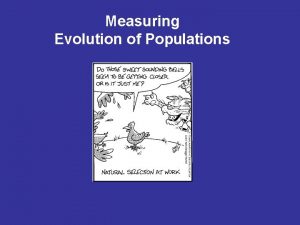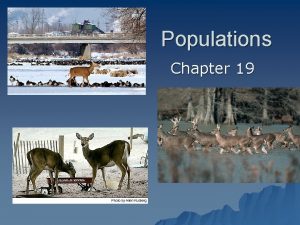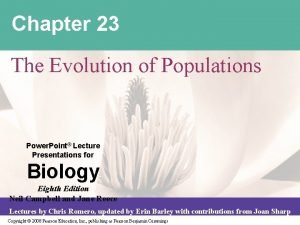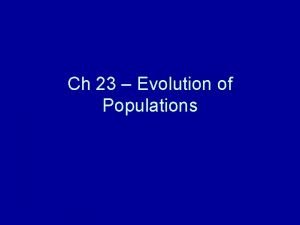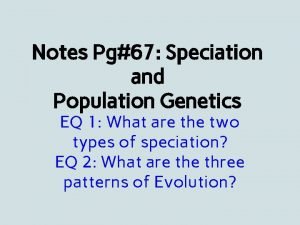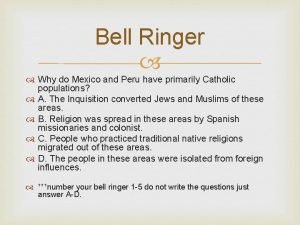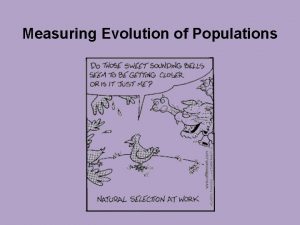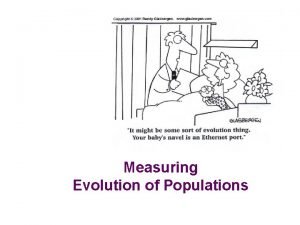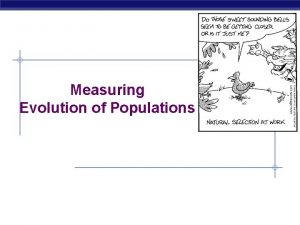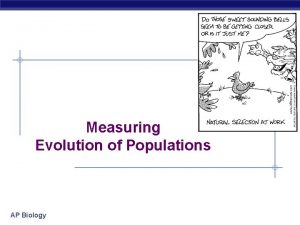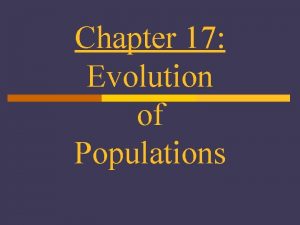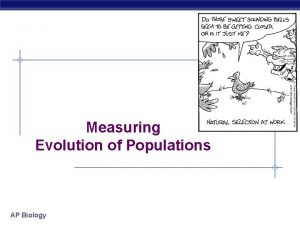Measuring Evolution of Populations 5 Agents of evolutionary
















- Slides: 16

Measuring Evolution of Populations

5 Agents of evolutionary change Mutation Gene Flow Genetic Drift Non-random mating Selection

Populations & gene pools • Concepts – a population is a localized group of interbreeding individuals – gene pool is collection of alleles in the population • remember difference between alleles & genes! – allele frequency is how common is that allele in the population • how many A vs. a in whole population

Evolution of populations • Evolution = change in allele frequencies in a population – hypothetical: what conditions would cause allele frequencies to not change? – non-evolving population REMOVE all agents of evolutionary change 1. very large population size (no genetic drift) 2. no migration (no gene flow in or out) 3. no mutation (no genetic change) 4. random mating (no sexual selection) 5. no natural selection (everyone is equally fit)

Hardy-Weinberg Principle original proportions of genotypes in a population will remain constant from generation to generation Sexual reproduction (meiosis and fertilization) alone will not change allelic (genotypic) proportions.

Hardy-Weinberg equilibrium • Hypothetical, non-evolving population – preserves allele frequencies • Serves as a model (null hypothesis) – natural populations rarely in H-W equilibrium – useful model to measure if forces are acting on a population • measuring evolutionary change G. H. Hardy Mathematician (1877 -1947) W. Weinberg Physician (1862 -1937)

Hardy-Weinberg Principle • Necessary assumptions Allelic frequencies would remain constant if… – population size is very large – random mating – no mutation – no gene input from external sources – no selection occurring

Hardy-Weinberg theorem • Counting Alleles – assume 2 alleles = B, b – frequency of dominant allele (B) = p – frequency of recessive allele (b) = q • frequencies must add to 1 (100%), so: p+q=1 BB Bb bb

Hardy-Weinberg theorem • Counting Individuals – frequency of homozygous dominant: p x p = p 2 – frequency of homozygous recessive: q x q = q 2 – frequency of heterozygotes: (p x q) + (q x p) = 2 pq • frequencies of all individuals must add to 1 (100%), so: p 2 + 2 pq + q 2 = 1 BB Bb bb

Hardy-Weinberg Principle • Calculate genotype frequencies with a binomial expansion (p+q)2 = p 2 + 2 pq + q 2 • p 2 = individuals homozygous for first allele • 2 pq = individuals heterozygous for alleles • q 2 = individuals homozygous for second allele

H-W formulas • Alleles: p+q=1 B • Individuals: p 2 + 2 pq + q 2 = 1 BB BB b Bb Bb bb bb

Hardy-Weinberg Principle Problem: 100 cats 16 are white 84 are black. What is the frequency of black and white allele in the population? • p 2 + 2 pq + q 2 • and • p+q = 1 (always two alleles) • • 16 cats white = 16 bb then (q 2 = 0. 16) This we know we can see and count!!!!! If p + q = 1 then we can calculate p from q 2 q = square root of q 2 = q = √. 16 q = 0. 4 p + q = 1 then p =. 6 (. 6 +. 4 = 1) P 2 =. 36 All we need now are those that are heterozygous (2 pq) (2 x. 6 x. 4)=0. 48 • . 36 +. 48 +. 16

Using Hardy-Weinberg equation population: 100 cats 84 black, 16 white How many of each genotype? p 2=. 36 BB q 2 (bb): 16/100 =. 16 q (b): √. 16 = 0. 4 p (B): 1 - 0. 4 = 0. 6 2 pq=. 48 Bb q 2=. 16 bb Must. What assume are population the genotype is in frequencies? H-W equilibrium!

HARDY-WEINBERG & EVOLUTION ANOTHER PROBLEM • Fraggles are mythical, mouselike creatures that live beneath flower gardens. • Of the 100 fraggles in a population, 91 have green hair(F) and 9 have grey hair(f). • Assuming genetic equilibrium: – What are the gene frequencies of F and f? – What are the genotypic frequencies?

ANSWERS TO PROBLEM Gene frequencies: F = 0. 7 and f = 0. 3 Genotypic frequencies FF = 49% or 0. 49 Ff = 42% or 0. 42 f f = 9% or. 09

Hardy Weinberg Illustration
 Agent of evolutionary change
Agent of evolutionary change 5 agents of evolution
5 agents of evolution Section 19-1 review understanding populations answer key
Section 19-1 review understanding populations answer key Evolution of populations section 11 review
Evolution of populations section 11 review Chapter 23: the evolution of populations
Chapter 23: the evolution of populations Chapter 23 the evolution of populations
Chapter 23 the evolution of populations Stabilizing selection human birth weight
Stabilizing selection human birth weight Evolution of populations section 16-1 genes and variation
Evolution of populations section 16-1 genes and variation Smallest unit of evolution
Smallest unit of evolution Chapter 16 evolution of populations vocabulary review
Chapter 16 evolution of populations vocabulary review Section 16-1 genes and variation
Section 16-1 genes and variation Chapter 17 evolution of populations answer key
Chapter 17 evolution of populations answer key Chapter 14 section 3 shaping evolutionary theory
Chapter 14 section 3 shaping evolutionary theory Agents of evolution
Agents of evolution Genetic drift
Genetic drift Edward jenner’s innovation helped to
Edward jenner’s innovation helped to Complex patient populations
Complex patient populations

